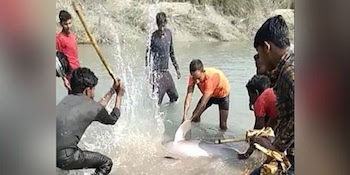A few weeks ago, three men were arrested in Uttar Pradesh, a state in northern India, after video of them beating an endangered river dolphin to death went viral and came to the attention of authorities. The attack involved at least seven men beating the dolphin with wooden rods, and at in one case with an axe. Eventually, they held their bleeding and bludgeoned victim under water until it suffocated. The dolphin was later found dead by a local forestry official, with numerous injury marks on its body to document its brutal and violent death.
Arrests were made after the video made identification of the men possible. Widely seen around the world, the footage is extremely hard to watch. Surrounded and without any hope of escape in the shallow water, the sound of blow after blow striking its body can be clearly heard. As is the sound of laughter from the men. This torture continued until the dolphin was dead. It is agonizing for any sane person to watch.
Now, to be clear, along with being illegal, this activity is not normal or unsurprising in Indian society. This particular dolphin is not only an endangered and protected species, but also happens to be the national aquatic animal of India. And neither are the people of India particularly tolerant of animal cruelty. In fact they are among the most compassionate, and the welfare of animals has a strong foothold in India.
Nevertheless, another element of this story that caught the attention of the world is that, even if convicted, these men are not going to face especially harsh legal consequences. The reason for this is that India’s Prevention of Cruelty to Animals Act was passed in 1960, at a time when standards for the treatment of other species were very poor compared to anything that would be drafted in most places around the world today. With a law that hasn’t been amended in 60 years, the threat of weak punishments does very little to deter even the most egregious cases of abuse.
So the pressure is now on the Indian Government to strengthen the laws, so that cases of this kind can result in serious charges in the future. I would go much farther and suggest that India, which was the first country in the world to recognize personhood rights for dolphins, should use this case to establish a legal precedent for what happens to those who choose to violate those rights. To establish a clear level of culpability for their violation. That when we say someone is a person, not a commodity or a resource or a thing – a person with rights – that we mean it.
So let’s learn a little more about the person who was victimized here, to put this case into sharp relief.
The South Asian river dolphin is a freshwater species found in the region of the Indian subcontinent. There are thought to be fewer than 5,000 left. Usually found in India’s Ganges and Pakistan’s Indus rivers, it is easily recognized by its long snout. Essentially blind, it hunts using echolocation – by emitting ultrasonic sounds which bounce off prey and return to the dolphin, enabling it to see an image in its mind. Locals refer to it as “susu,” a reference to the noise made when the dolphin breathes.
It has two subspecies, both highly endangered – the Ganges river dolphin, of which there are perhaps 3,500 remaining, and the Indus river dolphin, with only about 1,500. To make matters worse, the species has a relatively low reproductive rate. Females give birth once every two to three years , and to only one calf. So this make them extremely valuable simply from a conservation perspective. But dolphins are so much more than that.
Like their oceanic cousins, with whom most of us are more familiar, river dolphins are highly intelligent. Their emotional capacity rivals humans’, and they have complex social relationships with others of their kind. For these reasons, many of us naturally feel a special kinship with them. A fascination produced when a terrestrial intelligence encounters an aquatic one. Yet, that hasn’t prevented us from pushing many of their species to the edge of extinction, polluting their homes, or even slaughtering them for their meat and using their flesh to bait fish hooks. And perhaps worst of all, forcing them into miserable lives held captive in tiny concrete tanks.
Dolphins are indeed our kin. They are people too, and deserve to swim safe and free. This individual in Uttar Pradesh deserved so much better.
For The Orca’s Voice,
Dani, Canadian Cetacean Alliance



Leave a Reply